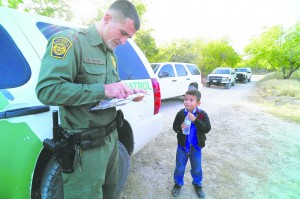Images of unaccompanied minors walking through the desert and making their way into the U.S. have receded from the airwaves.
It was back in 2014 when the issue exploded on national media, with pundits weighing in, left and right, on the crisis. Videos of unfazed children standing by Border Patrol cars were seen by millions of people, including legislators in Washington D.C.
Two years later, the issue is far from over. Mass media coverage may have subsided, but tens of thousands of migrant children are still crossing into American soil without their parents.
During the 2016 fiscal year, a total of 606 unaccompanied minors were detained by border agents in San Diego County alone. According to U.S. Customs and Border Protection, this marks a significant increase when compared to 2015, when 396 minors were detained locally.
These numbers are actually relatively low when compared to other states along the U.S/Mexico border. In the ‘Rio Grande’ area, which includes land in Texas and New Mexico a total of 13,946 minors were detained during that same fiscal year. Throughout the Southwest border, the number stands at 23,553. (The fiscal year ran from October 1, 2015 to February 29, 2016).
So what happens after these kids are taken into custody? Once all the paperwork is filed, the minors are usually assigned to shelters for unaccompanied minors. In San Diego County there are two centers dedicated to this.
One center is a 14-bed facility in Lemon Grove. The other is an 11-bed center in El Cajon. Both are run by Southwest Key Programs, a national non-profit that’s hired by the U.S Department of Health and Human Services. Its purpose is to care for minors while their immigration case is sorted out. Usually the minors are housed in the shelters for about a month, while authorities locate their parents back home or family members already living in the U.S. The minors do face deportation procedures, but in the meantime they live in designated shelters. Most of the children are from Central America, where violence is rampant. The majority come from El Salvador, then Guatemala and Honduras, respectively.
According to Southwest Key Programs’ website, the shelters “operate as a self-contained unit, delivering shelter, food, healthcare, education, recreation, case management and legal services to the children in our care.”
Even though all costs are covered by the federal government, not all neighborhoods welcome these type of shelters, especially with immigration being such a divisive issue. A third temporary shelter was considered in Escondido, but ultimately the project was denied by the city’s council back in October 2014. It would have given temporary housing to about 100 migrant children. Interestingly, the city or state where minors are detained doesn’t necessarily determine what shelter they will be assigned to. So a child detained in Texas could be transferred to a shelter in another state with more available resources.
The concept of actually having a shelter for unaccompanied minors is relatively new. In the mid 1990’s immigrant children were kept in federal detention facilities, while their case was pending. But after a lawsuit, the U.S Supreme Court deemed those conditions unconstitutional. This ruling required the federal government to provide a more humane condition for the children, even as they faced deportation.
Now the issue has shifted into the presidential arena. While Republican candidates may slightly differ on their position, they overwhelmingly support the building of a border wall and tightening security along the border. Interestingly enough, it is the democratic candidates who strongly disagree on how to deal with unaccompanied immigrant minors.
During a televised debate in Milwaukee, Senator Bernie Sanders, pressed former Secretary Hillary Clinton about her stance on deporting these minors.
“Secretary Clinton, if my memory is correct,” began Sanders, “I think when we saw children coming from these horrendous, horrendously violent areas of Honduras and neighboring countries, people who are fleeing drug violence and cartel violence, I thought it was a good idea to allow those children to stay in this country. That was not, as I understand it, [your] position.”
Clinton defended the policy, adding that not putting a stop to the mass migration of children can trigger a domino effect. By supporting their deportation, she argued, she was discouraging other families from sending their children on the dangerous and sometimes deadly journey.
“The fact is that there was a great effort made by the Obama Administration and others to really send a clear message,” said Clinton. “We knew that so many of these children were being abused, being treated terribly while they tried to get to our border.”
According to the New York Times, President Obama eventually approved a plan where children from these conflict ridden areas in Central America, could apply for refugee status.
As the presidential election moves forward, the issue will surely be discussed time and time again. Especially since statistics show that despite the media hoopla and political promises from the left and right, tens of thousands of unaccompanied minors are still risking it all, as they try to make to the U.S.
